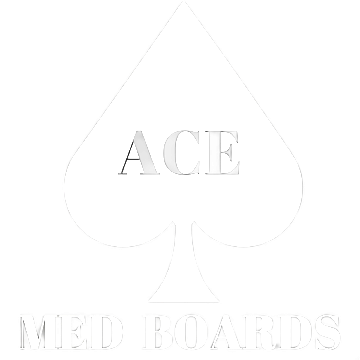Diving into the residency application process can feel like you're staring up at a mountain with no clear path. But trust me, having a solid roadmap makes all the difference. The entire ERAS residency application timeline is a year-long marathon, kicking off with prep work in the spring and hitting the finish line with Match Day the following March. Getting a handle on these key phases is your first step toward a confident, organized, and—most importantly—successful application season.
Decoding the ERAS Application Timeline
Let's be clear: the residency application process is a long game. It’s not something you can cram for. It demands meticulous planning and a sharp eye on the critical deadlines set by both the Electronic Residency Application Service (ERAS) and the National Resident Matching Program (NRMP). Missing a key date can seriously sideline your chances, so the very first thing you should do is create a personal calendar based on the official schedule.
This guide will break that year-long journey down into manageable chunks. From grinding out your personal statement and locking down letters of recommendation over the summer to navigating the whirlwind interview season in the winter, each period has a specific purpose. If you approach the year with a strategic mindset, you'll avoid that last-minute panic and show program directors the best version of yourself.
To give you a bird's-eye view of how the year breaks down, it's helpful to see the major stages. The process isn't just one long sprint; it's a series of distinct phases, each with its own objective.
Key Phases of the ERAS Application Cycle
| Phase | Typical Timeframe | Primary Objective |
|---|---|---|
| Preparation Phase | April – June | Gather documents, request Letters of Recommendation, and begin drafting your Personal Statement and Experiences. |
| Application Opening | June – Early September | Register your MyERAS token, upload all documents, and meticulously fill out every section of the application. |
| Submission & Certification | September | Certify and submit your application to programs. Aim to submit on the very first day programs can begin reviewing. |
| Interview Season | October – January | Respond to interview invitations promptly, prepare for interviews, and attend virtual or in-person interviews. |
| Ranking & Match | February – March | Create and certify your Rank Order List (ROL) with the NRMP, leading up to Match Week in mid-March. |
This table simplifies the journey, but within each phase are critical, non-negotiable dates you absolutely cannot afford to miss.
Key Milestones You Cannot Miss
Certain dates are set in stone. For instance, in the upcoming 2026 ERAS season, you can get your token and start working on the application as early as June 4, 2025. However, the first day you can actually submit that application to programs is September 3, 2025. Knowing these dates way ahead of time is the secret to staying ahead of the curve. You can find more analysis on how application numbers are trending over at The Match Guy.
A successful match isn't just about having a great application; it’s about managing the timeline like a pro. Submitting on time—with a polished, complete application—sends a huge signal to programs about your professionalism and dedication before they even read a word.
This visual timeline gives you a great snapshot of the major milestones, from the day the application opens all the way through the thick of interview season.
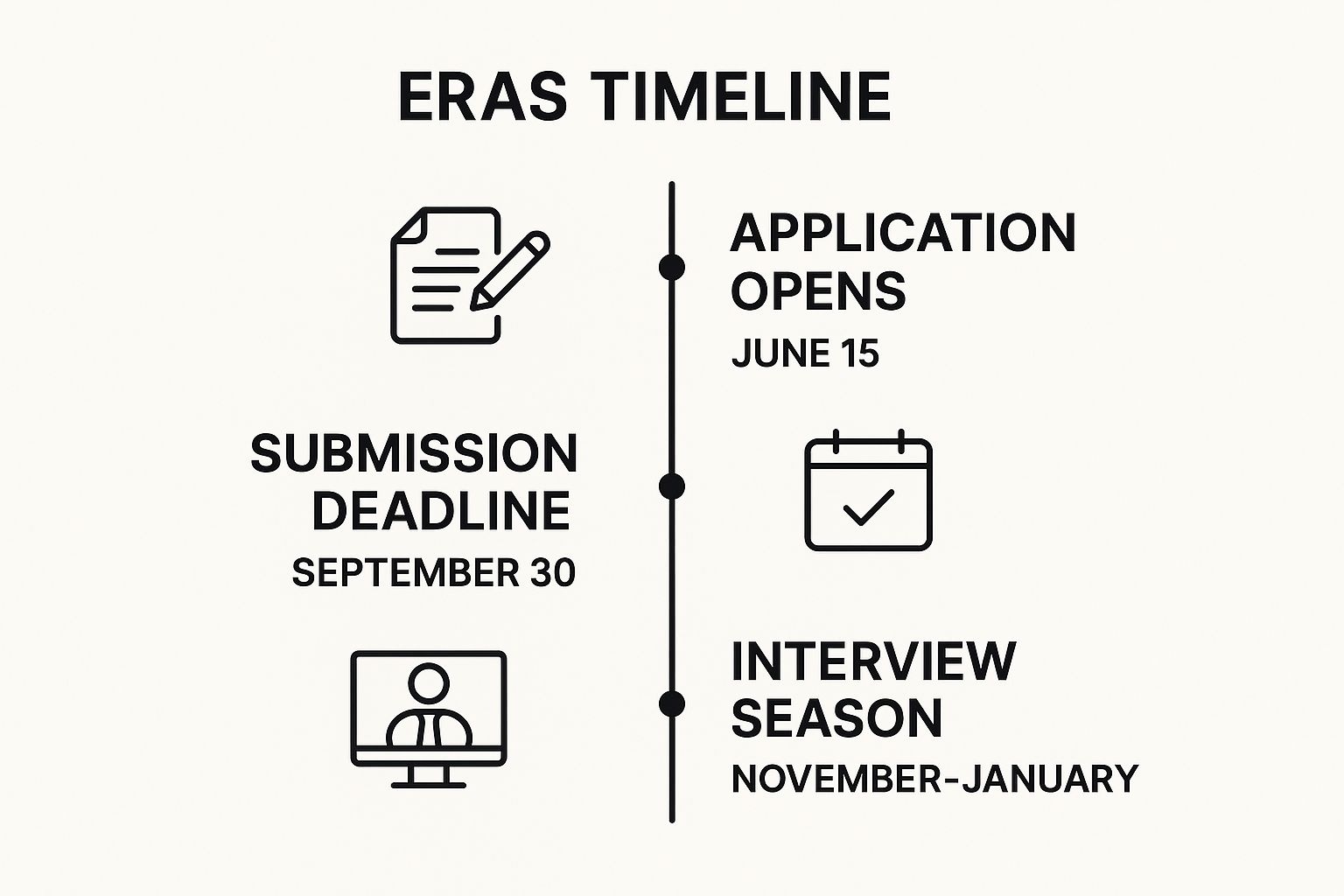
As you can see, the window between September and January is when the magic happens—it’s when programs are reviewing applications and sending out interview invites. This makes all the prep work you do in the spring and summer absolutely essential.
Building Your Application from June to August
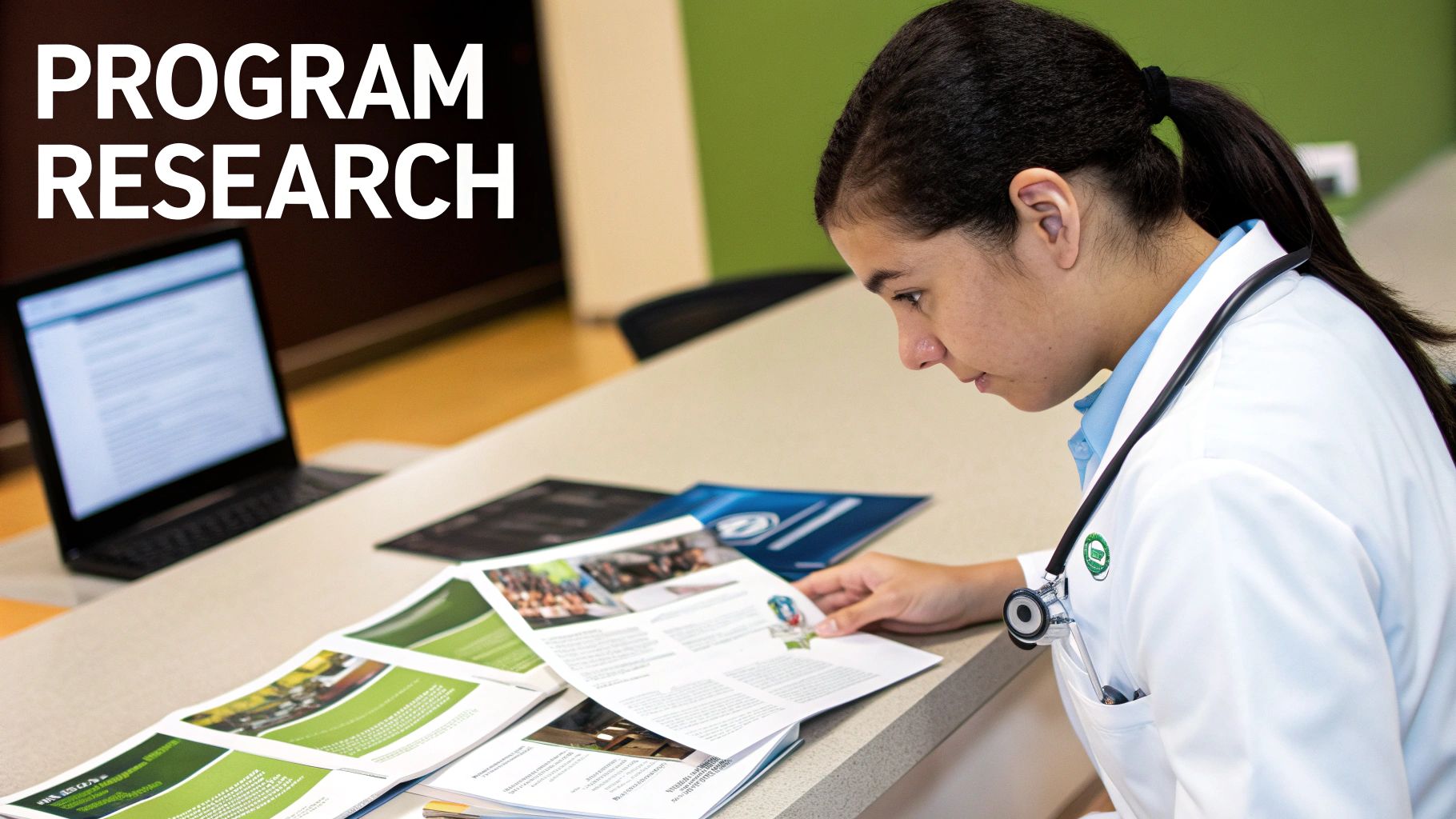
The summer is when all your planning starts to become real. This stretch of your ERAS residency application timeline is less about hitting hard deadlines and more about doing the focused, strategic work that builds a standout application.
It all kicks off in June when you get your ERAS token from your medical school (or ECFMG for IMGs) and officially register on the MyERAS portal. This simple step unlocks the system and signals the real start of the application season. Now, the real work begins.
With portal access, your job is to meticulously build out each section. Summer is the time to frame your experiences, research, and volunteer activities not just as a laundry list, but as a compelling story of your growth and commitment to medicine.
Polishing Your Personal Statement
Your personal statement is the soul of your application. Let me be clear: writing a good one takes time, patience, and a lot of rewriting. Don't make the classic mistake of waiting until August to start. You should be drafting this in June to give yourself plenty of runway for writing, getting feedback, and refining it until it shines.
One of the biggest pitfalls is trying to be everything to every program. Instead, anchor your statement around a core theme or a powerful story that shows why you chose this specialty. Maybe it was a specific patient encounter or a personal challenge that solidified your path. This is your one real chance to connect with program directors on a human level.
A few tips from experience:
- Show, Don't Tell: Instead of saying you're compassionate, describe a moment where your compassion genuinely impacted a patient's care.
- Get Outside Eyes: Ask trusted mentors, advisors, and even a friend outside of medicine to read your drafts. Someone without a medical background can quickly spot confusing jargon or awkward phrasing.
- Proofread Like Your Career Depends On It: Because it does. A single typo can completely undermine an otherwise brilliant statement. Read it aloud, print it out, and use every tool you have to make it flawless.
If you're feeling stuck on how to structure everything, looking at a sample ERAS application can be a huge help. Seeing a completed profile often demystifies the process and gives you a solid framework for organizing your own story.
Securing Strong Letters of Recommendation
Great Letters of Recommendation (LoRs) are non-negotiable. Most programs want three, but I always advise aiming for four to give yourself some flexibility. You should have already floated the idea to potential writers in the spring, but summer is when you make the official ask and give them what they need to write a stellar letter.
When you make the request, hand them a packet with all your relevant documents. This isn't being pushy—it's being professional. You're making their job easier, which always results in a better letter for you.
Pro Tip: Your LoR support packet should include your CV, your personal statement draft, and the ERAS Letter Request Form. I also recommend including a short paragraph summarizing your career goals and gently reminding them of a specific case or project you worked on together to jog their memory.
Follow up politely as the summer wears on. Attendings are incredibly busy people, and a gentle nudge in August can ensure your letters get uploaded before the September chaos. Your goal is to have all supporting documents—LoRs, MSPE, USMLE transcript—requested and in the works by the end of August. Do this, and you’ll be set up for a much less stressful submission day.
September: The Strategic Application Launch
September is go-time. All the months of hard work finally come together, and this is where the ERAS residency application timeline shifts from preparation to execution. This isn't just about clicking "submit"; it's about launching your application with a sharp, strategic edge. The mission is to get your file in front of the right people at exactly the right time.
So, does submitting on the very first day actually matter? The answer from experienced applicants and advisors is a resounding yes.
While programs can't actually see your application until a specific date later in September, getting it in early means your file is complete, processed, and waiting in the queue the second they log on. Program coordinators are staring down a mountain of applications. Being in that first wave ensures you're seen before the inevitable reviewer fatigue kicks in.
The Final Pre-Submission Checklist
Before hitting that final "Certify and Submit" button, you need to do one last meticulous review. This is non-negotiable. Once you certify, most of your application is permanently locked. Think of this as your final pre-flight check before takeoff—catching a small error now can save you from a major headache later.
Triple-check these critical areas:
- Proofread Everything (Again): Read every single word of your personal statement, experiences, and activities. Seriously. Read it aloud to yourself to catch clumsy phrasing or typos your eyes might otherwise skim over.
- Check Your Document Assignments: This is a classic mistake. Make absolutely certain you've assigned the correct personal statement and Letters of Recommendation to each program. Sending a family medicine-focused letter to an orthopedic surgery program is a cringeworthy—and avoidable—error.
- Verify Your Program List: Double-check the names and ACGME codes for every single program. Accidentally applying to a program's preliminary track instead of the categorical one you wanted is a surprisingly common and costly mistake.
Once you’re absolutely confident it's perfect, you can submit. This isn't just a technical step; it's a huge milestone. Take a moment to breathe and acknowledge the accomplishment.
Smart Program Selection and Signaling
Applying broadly isn't a strategy—it's just expensive. You need to be thoughtful and deliberate about where you send your application. This is where tools from the AAMC, like the Residency Explorer, become invaluable. It provides hard data on thousands of programs, helping you find places that are a genuine fit for your profile, not just a shot in the dark.
This data-driven approach is also essential for using your program signals wisely. These signals are your way of raising your hand and telling a handful of programs, "Hey, I'm genuinely interested in you."
Don't waste them. Don't signal your home program or a place where you're a shoo-in for an interview. Instead, allocate them strategically:
- "Reach" but Realistic Programs: Signal a few programs you'd be ecstatic to attend, even if they feel like a slight stretch. A strong signal can make a program director take a second look.
- High-Fit Programs: Use the majority of your signals for programs where your stats, research, and experiences align perfectly with their mission and what they look for in residents.
By signaling, you’re not just expressing interest; you're actively guiding a program director’s attention toward your application in a sea of thousands. It’s one of the most powerful tools you have to increase your visibility.
Finalizing your program list and assigning signals takes careful thought. This strategic component, paired with the compelling narrative in your written sections, is what makes an application truly stand out. For a deeper dive into crafting the most important part of that story, our guide on the ERAS personal statement offers expert advice to help you shine.
Get this right, and you'll set a powerful foundation for the entire interview season.
Navigating Interview Season From October To January
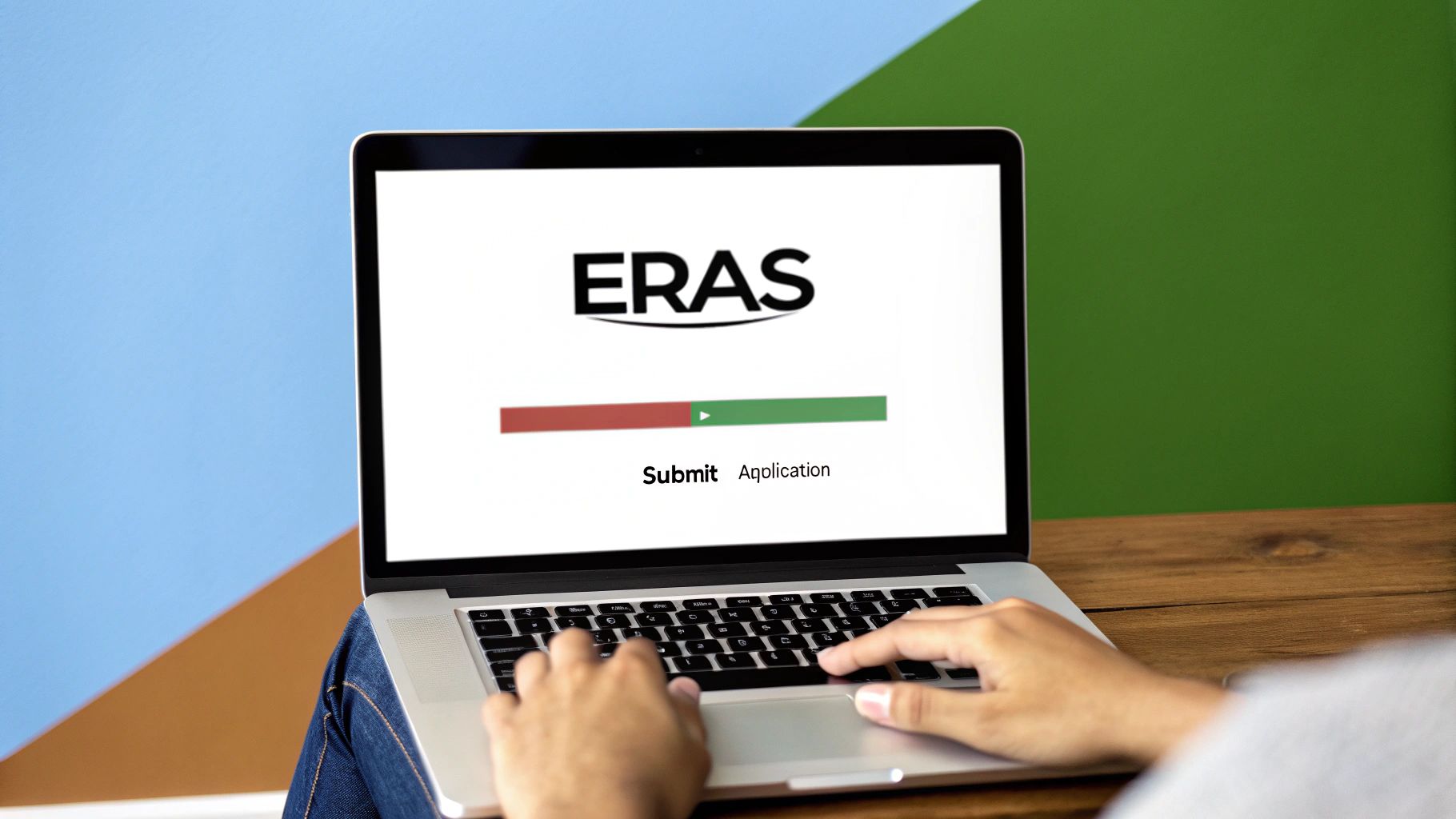
Once you hit "submit" on your application, the ERAS residency application timeline enters a whole new phase. From October through January, your focus pivots from crafting the perfect application to actually connecting with programs during interview season. This is where your hard work on paper comes to life.
The first interview invitations can start arriving as early as October, sometimes just days after programs get access to your application. You need to be ready. These invites often demand a quick response—usually within 24-48 hours—to secure an interview slot. If you hesitate, you could lose your spot to another applicant, so make sure your email notifications are on and you're checking your inbox religiously.
Mastering Interview Logistics And Preparation
Juggling your interview calendar is one of the first real challenges of this season. Most programs will offer a few different dates, and it's on you to schedule them without creating overlaps, all while managing different time zones. Get a reliable digital calendar set up and respond to invites the moment they come in. It's perfectly fine to tentatively accept while you firm up your other commitments.
For each interview, your prep work needs to be deep and specific. Don't just skim the program's homepage. Your mission is to genuinely understand their culture, their values, and what makes them unique.
- Dive Deep into Research: Look up recent publications from the faculty you'll be meeting with. Check out the program's social media feeds to get a real sense of the resident community and day-to-day life.
- Talk to Current Residents: If you can, reach out to residents in the program. Ask them about their daily schedules, call responsibilities, and the kind of support they receive. This is where you get the unvarnished truth.
- Prepare Thoughtful Questions: Come up with questions that show you've done your homework and can't be answered with a quick Google search. For instance, instead of asking, "Are there research opportunities?" try something like, "I read about Dr. Smith's work on [specific topic]; can you tell me more about how residents get involved in that specific lab?"
An interview is a two-way street. You aren't just there to be evaluated; you're also there to figure out if this is the right place for you to spend the next three to seven years. Come ready to learn just as much as you are to impress.
Excelling In Virtual And In-Person Interviews
Most interviews these days are virtual, which brings its own set of rules. While convenient, they demand a different kind of preparation. Make sure you have a professional, uncluttered background, good lighting, and a rock-solid internet connection. Do a full tech run-through beforehand to iron out any potential glitches. For a great breakdown of the virtual format, check out these tips on How to Prepare for a Video Interview and Win the Job.
Whether it's over a screen or across a table, the heart of the interview is the same: telling your story. You need to clearly articulate your motivations, your strengths, and what brought you to this point. Practice answering common questions out loud—it helps smooth out your delivery and makes you sound more confident. For more targeted coaching and strategy, our guides on medical residency interview preparation can give you the extra edge you need to truly shine.
Don't forget the final touch. After each interview, send a brief, personalized thank-you email within 24 hours. Reference specific things you discussed to jog their memory and show you were paying attention. It's a simple, professional gesture that reinforces your interest and leaves a lasting positive impression.
Mastering Your Rank List and Match Week
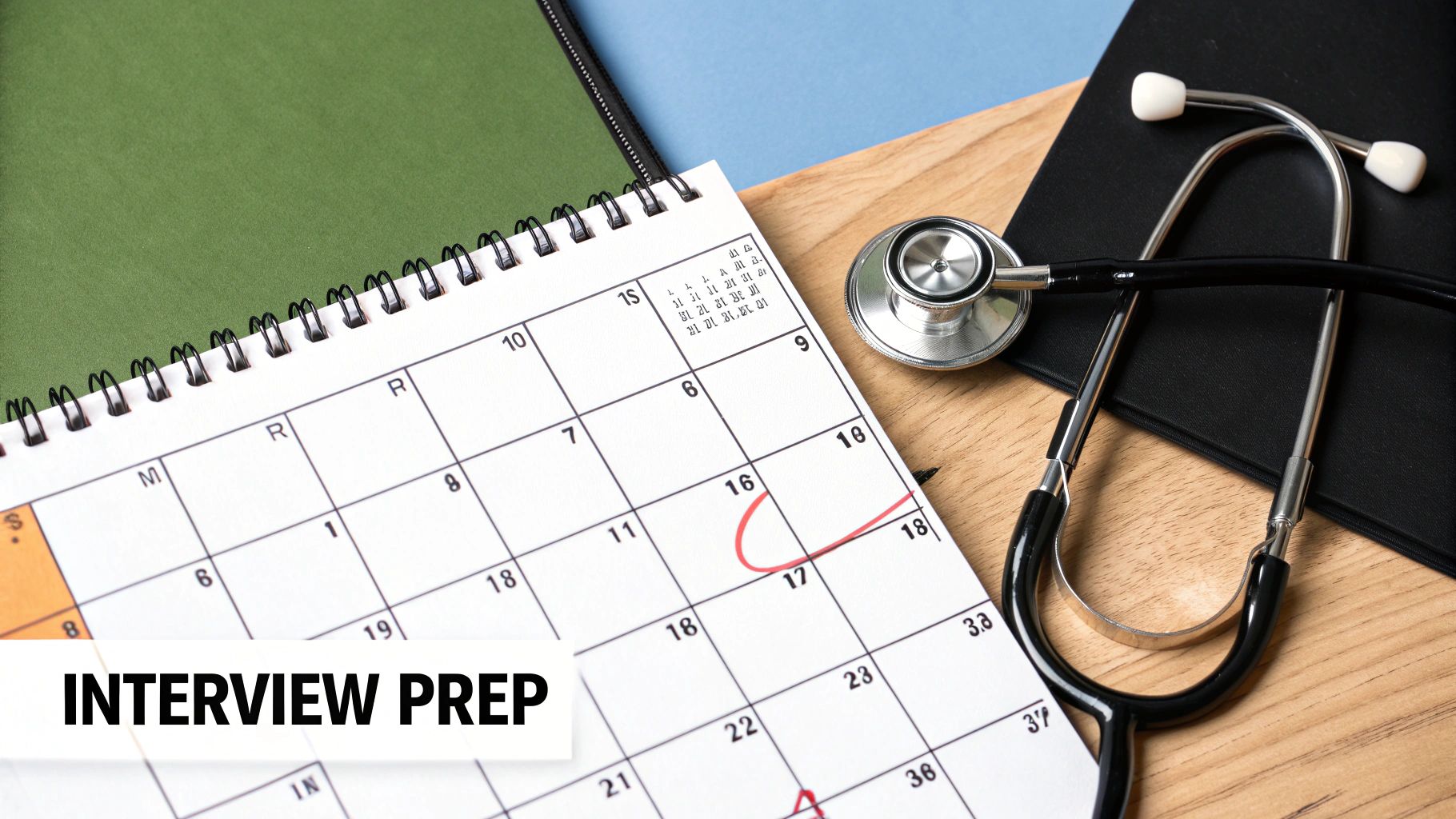
As the whirlwind of interviews slows down, the ERAS residency application timeline enters its final, most intense phase. From February to March, your attention pivots to the National Resident Matching Program (NRMP) as you build and certify your Rank Order List (ROL). This is it—the culmination of years of relentless work, all coming down to a handful of incredibly important decisions.
Your ROL needs to be a pure reflection of what you want. It's a common mistake to try and "game the system" by ranking programs based on where you think you'll match. Don't do it. The matching algorithm is designed to favor you, the applicant, by trying to place you as high up on your own list as possible. Ranking a program you love lower because you think it’s a "reach" only works against you, especially if they happened to rank you highly too.
Crafting Your Rank Order List
Putting together your ROL is a soul-searching process that demands some serious reflection. It's time to think back through every interview day, every conversation, every gut feeling. Where did you truly connect with the residents and faculty? Which program’s mission and culture felt like a place you could not just survive, but thrive?
As you start ordering your list, weigh these factors carefully:
- Program Culture: Was the vibe supportive and collaborative, or did it feel like a pressure cooker? The environment you're in for the next 3-7 years will have a massive impact on your well-being.
- Geographic Location: Be honest with yourself about your personal life. Think about family, your partner, the cost of living, and what you need outside the hospital walls. A stellar program in a city you can't stand is a recipe for burnout.
- Career Goals: Look beyond intern year. Does the program have a track record of strong fellowship placements? Are there research opportunities that align with your passions? Will it open the doors you want opened down the road?
Once your list feels right, there's one final, non-negotiable step. You must certify your ROL with the NRMP before the deadline, which usually lands in early March. An uncertified list is the same as not participating in the Match at all. Don't let a simple click undo years of hard work.
Understanding Match Week and SOAP
Match Week in mid-March is an emotional marathon. The week kicks off on Monday, when you find out if you matched—but not where. This one piece of information sets the tone for everything that follows.
If you find out you didn't match, it's a gut punch. There's no sugarcoating it. But you have to pivot, and you have to do it fast. The Supplemental Offer and Acceptance Program (SOAP) kicks off almost immediately. SOAP is a structured, fast-paced process for eligible unmatched applicants to apply to and receive offers from residency spots that went unfilled.
It's so important to remember this: not matching is not a verdict on your worth or your potential as a doctor. Many fantastic, highly qualified candidates go through SOAP every single year and land in great programs. The key is being prepared for the possibility and engaging with the process professionally the moment it begins.
The week builds to its climax on Match Day, a Friday, when every matched applicant in the country discovers where they're heading for residency. Whether you match on Monday or secure a spot through SOAP, this day is a monumental achievement. It's the start of the next chapter of your medical career.
Managing ERAS Application Costs and Financial Aid
Let’s talk about the elephant in the room: the cost. Applying to residency is a serious financial investment, and honestly, the fees can pile up faster than you’d expect. Staying on top of these costs is a huge part of managing your ERAS timeline successfully.
First things first, you need to get a handle on the fee structure. ERAS uses a tiered system, meaning you pay a base fee for a set number of applications, and then the cost per program goes up from there. It's not a simple flat rate, so applying to 50 programs will cost a whole lot more than applying to 20.
Finding Financial Support
The good news? You’re not entirely on your own. There are resources out there to ease the financial burden. The AAMC Fee Assistance Program is a lifeline for many applicants, offering significant discounts on ERAS fees if you qualify.
Even better, the 2025 ERAS season brings some welcome changes to the fee structure, making the process more affordable for everyone. Most applicants can expect to save up to 36% compared to what people paid in previous years. Plus, if you're eligible, you'll automatically get a 60% discount for up to 50 applications. You can dig into the details on these updates directly from the AAMC.
Don't let financial anxiety dictate your application strategy. Do your homework on fee assistance programs now and budget for both application and interview costs early. This will free you up to focus on what really matters—finding the residency program that’s the right fit for you.
If you need help covering immediate expenses, you might also want to look into various personal loan options. A little planning upfront can prevent finances from becoming a major source of stress down the road.
Answering Your Biggest ERAS Timeline Questions
Navigating the residency application process always stirs up a lot of questions. Let's cut through the noise and tackle some of the most common ones I hear from applicants, so you can move forward with confidence.
How Many Programs Should I Apply To?
There's no single magic number here, and blindly following a "more is better" strategy can backfire. It's not just expensive; it's mentally draining. The real key is finding a strategic balance.
Applying to too few programs obviously limits your chances, but applying to too many can lead to serious burnout before interview season even starts. Your best bet is to create a tiered list of programs that you would genuinely be excited to attend. Include your "safety" schools, your "target" programs, and a few "reach" programs.
Most applicants I've worked with land somewhere between 30 and 70 programs. But remember, this can swing wildly depending on how competitive your chosen specialty is.
When Is the Best Time to Submit My ERAS Application?
Aim to submit your application on the very first day that residency programs can access them, or as close to it as humanly possible.
Yes, there's a submission window, but don't let that fool you. Program directors and coordinators start downloading and reviewing applications immediately. Submitting on day one ensures your application is in that crucial first wave, getting seen before reviewer fatigue inevitably kicks in.
Of course, don't sacrifice quality for speed—a rushed, sloppy application is worse than a slightly later, polished one. But the goal should be to have everything finalized and ready to go for opening day.
A word of caution: Once you certify and submit your application, most of it is locked in for good. You can’t go back and tweak your personal statement, experiences, or which letters are assigned to which programs. You can update your contact info and upload new LoRs for later assignment, but that’s about it.
What Are the Biggest Mistakes Applicants Make?
Year after year, I see the same preventable mistakes trip up otherwise great candidates. They usually boil down to small details that unfortunately signal a lack of care or attention.
Please, avoid these common pitfalls:
- Typos and Grammatical Errors: I can't stress this enough. Proofread your entire application until your eyes hurt, then have someone else do it. A single silly mistake can completely undermine the professional image you're trying to project.
- Generic Personal Statements: Programs can spot a generic, mass-mailed essay from a mile away. You have to tailor your statement to the specialty. Show them you've thought deeply about why this field is the one for you.
- Missing Deadlines: This is the cardinal sin of the application cycle. It’s the easiest mistake to avoid yet the most damaging one you can make. Keep a detailed calendar with every single deadline and check it daily. This is the single most critical part of managing the ERAS residency application timeline.
Trying to manage all these moving parts alone can feel overwhelming. Ace Med Boards provides personalized residency admissions consulting to help you build an application that stands out and match with a program you love. Get your free consultation today and let's make a plan.
